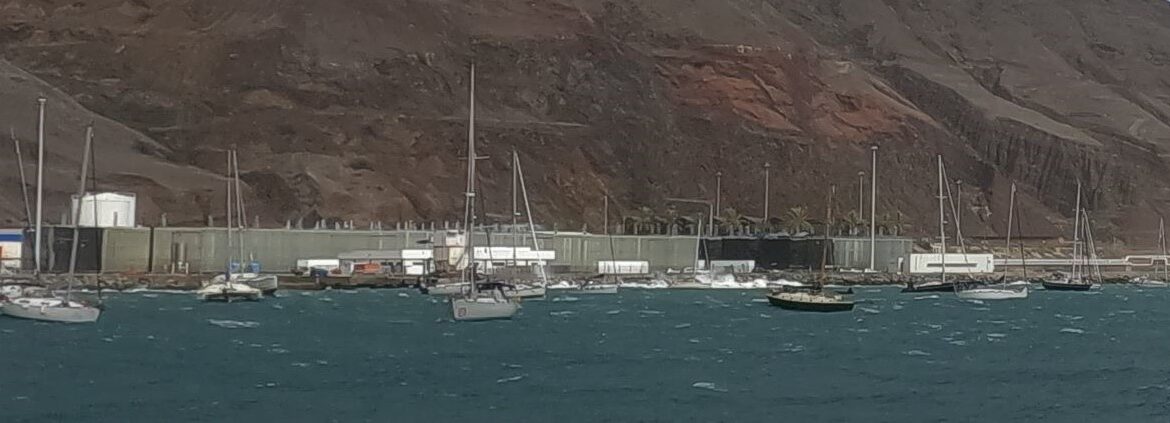As we’re sitting through a few days of strong winds, it seemed like a good time to write about when the wind blows in Porto Santo.
The winds received in Porto Santo and Madeira are generally controlled by the position of the Azores High. Typically, during the summer months, the resulting wind blows from the north or north east. The wind travels down the coast of Portugal and continues blowing on down across the Madeira island group.
The harbour in Porto Santo is on the south side of the island, and is well placed to provide protection from these winds. In addition, the encircling walls limit the effects of waves and swell.
What is the Azores High
The Azores High (also known as the Bermuda High) is a semi permanent area of high pressure. Its name comes from its position, located in the middle of the north Atlantic Ocean, to the south east of the Azores. Winds flow clockwise around the high pressure centre, resulting in the north/north east winds trade which blow down the Portuguese coast. The Portuguese explorers utilised these winds to aid them on their voyages of discovery around the Atlantic.
When the high is in place, the low pressure systems that form in the western Atlantic are subsequently blocked and pushed north as they sweep across the Atlantic.
However, the high pressure system does wander around, particularly during the autumn and winter months. When this happens, low pressure systems can then squeeze in to the south. Winds blow anticlockwise around a low pressure system. This results in southerly and west winds blowing across the islands. As well as the wind they also bring swell and waves from those directions. In October 2023, the impact of the rain and wind prevented us from completing our boatyard jobs on Emerald.


Does Porto Santo Provide Good Shelter?
Overall, Porto Santo harbour provides very good shelter for boats, even better than the marinas in Madeira. It has large surrounding walls, with three pronged concrete blocks around the outside to break up the waves. A mooring and anchoring field occupies the northern, landward portion of the space. The southern section is reserved for the manoeuvres of the ferry and cargo ships. To the west are the pontoons, mostly with finger berths as well as a long alongside pontoon and hammerhead. An inner wall provides some shelter for the pontoons.
The sea bed within the harbour is mostly sand with patches of weed. We found the holding to be very good during the month we spent on anchor.
There are approx. 16 moorings laid across the northern side. Thick ropes lead down to large concrete blocks. The mooring lines were renewed in 2023.

The North Wind Doth Blow
Given that the prevailing winds are from the north to north east, the harbour is generally well sheltered by the land. However, when the winds are particularly strong from those directions, especially over 20 knots, katabatic gusts barrel down off of the steep hillsides.
This week we’ve sat through 5 days of strong north east winds. From time to time, everything would go calm, with the wind meter showing just a few knots. Lulled into a false sense of security, we’d think the storm had passed. Then a vicious 30kt gust would blast us, making itself known as it howled through the rigging. Emerald would be jerked backwards, the mooring lines creaking as they pulled taut. And, despite tidying and securing things on deck, the wind seemed particularly skilled at finding the tiniest chink to rattle through. I can confirm that it is a good form of torture, especially when trying to sleep.
East Winds
Due to the interior size of the harbour, strong winds from the east can create a short chop across the harbour.
The Effects on Porto Santo from South to South West Winds
However, it is winds from a southerly round to south-west direction that can cause issues for the harbour. The harbour entrance is open to the south west, but typically any swell with a southerly component finds its way inside. The surrounding walls do break up the surface waves, however, the swell still enters. It rolls in through the gap, spreading out as it goes. When it reaches the shore, it crashes against the blocks and rubble along the inner edges of the harbour. As it surges through the anchorage and mooring field, it lifts, twists and rolls the boats. This results in a very uncomfortable motion for those onboard.
Also, the swell often persists after the wind has eased. In this situation the boats may no longer be lying to the direction of the swell and roll side to side rather than bow to stern. This creates an even more uncomfortable motion onboard.
Even the boats on the pontoons aren’t safe. The swell lifts everything, the wind blows over the wall and the jiggling starts. Lines creak and boats jerk when the lines snap taut.

Named Storms
Storms that are particularly strong and meet a threshold criteria are named by the regional meteorological services. In this area, it is a collaboration between the Portuguese, French and Spanish agencies. By naming them, the aim is to raise awareness of the storms and their potential impact from the strong weather that they will bring. During our time in Porto Santo, a handful of named storms have impacted the island, the most memorable I’ve mentioned below.
Storm Oscar
There are outliers to the typical weather pattern of storms only arriving outside of the summer months. Storm Oscar brought heavy rain and strong winds in the first week of June 2023. A record amount of rain fell in Madeira, leaving many people homeless. Strong southerly winds battered both islands.

Storm Bernard
Storm Bernard caused a lot of chaos in the harbour when it passed through in October 2023. We recorded a gust of 54 knots from our position in the boatyard.
This was during the busy season in Porto Santo, when the harbour is a popular resting place for boats waiting to go on to the Canary Islands. Hence, the anchorage was very full. Boats dragged their anchor, dinghies flipped and one yacht ended up lying against the shore. In that case it wasn’t the mooring that broke, but the yacht’s anchor chain that snapped. The community came together to rescue and tow where they could. In the case of the beached yacht, ultimately, the harbour pilot boat had to tow it off the rocks and take it to by lifted into the boatyard.
If you’d like to watch a video of the impact from storm Bernard on boats in the harbour, check out this one here by Sailing Make My Day.


Storm Irene
If there was one good thing from being in the boatyard, it was that we got to sit out the majority of the storms that passed through. We would watch from Emerald’s bow, perched high in the yard, feeling grateful to not be rolling and bouncing around in the harbour. But in January we got to experience our first named storm whilst in the water. Storm Irene passed over bringing two days of unpleasant conditions. We were alongside a pontoon, itself attached to a wall with runners so that it can rise and fall with the tide. The swell crept around the wall and snaked its way along the pontoon.
Emerald jerked back and forth, her multiple mooring lines snatching tight, then loose. Every so often the pontoon let out a metallic shriek as it was pulled against the runners whilst rising up and down. The wall is hollow to absorb some of the swell, but at high tide, the noise from the water surging around inside it sounded like there was an angry sea monster trying to break out. The resulting cacophony of creaking lines, squealing pontoon runners and a grumpy sea monster meant that we didn’t get much sleep that night.
Where Has All The Sand Gone?
Porto Santo is famed for it’s 9km long, golden, sandy beach and has won many awards for it. It is the reason why many people holiday there. The beach fringes the southern side of the island and so is generally very sheltered from the wind. But, a strong southerly also affects the beautiful beach. The wind creates large waves, which roll towards the beach and break in a frothy shower of spray. The golden sand becomes an expanse of grey pebbles as the pounding waves take the top layer of sand away. However, it doesn’t take too long for nature to repair the damage. Over the weeks following a storm, the prevailing currents of the island gradually bring the sand back, and the beach is soon looking beautiful again.


In Conclusion for When the Wind Blows in Porto Santo
So, when the wind blows in Porto Santo, is it a safe place to be for a boat?
Porto Santo harbour provides good shelter from most wind directions, but especially the prevailing north to north east winds. Although is is not completely protected from storms with strong southerly winds, the good thing is that they do tend to pass over very quickly. Plus, if this all sounds like gloom and doom, it’s worth remembering that these adverse conditions only come along a few times in a year.
The Social Media Bit: Want to Follow Us?
If you’d like to follow us on other social media platforms (Facebook, Instagram and YouTube), you can do so by using these links:
Or use the link below to track our voyage on NoForeignLand.com.
And finally, you can sign up to receive email notifications of new blogs using the subscribe box at the bottom of this page.
Thank you from Nichola & Colin


